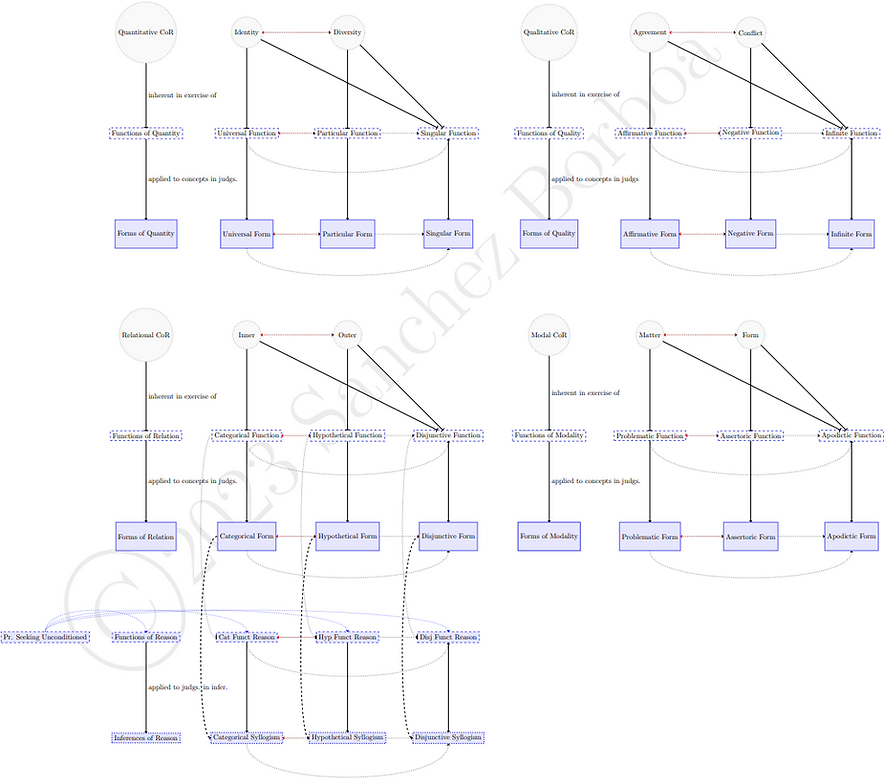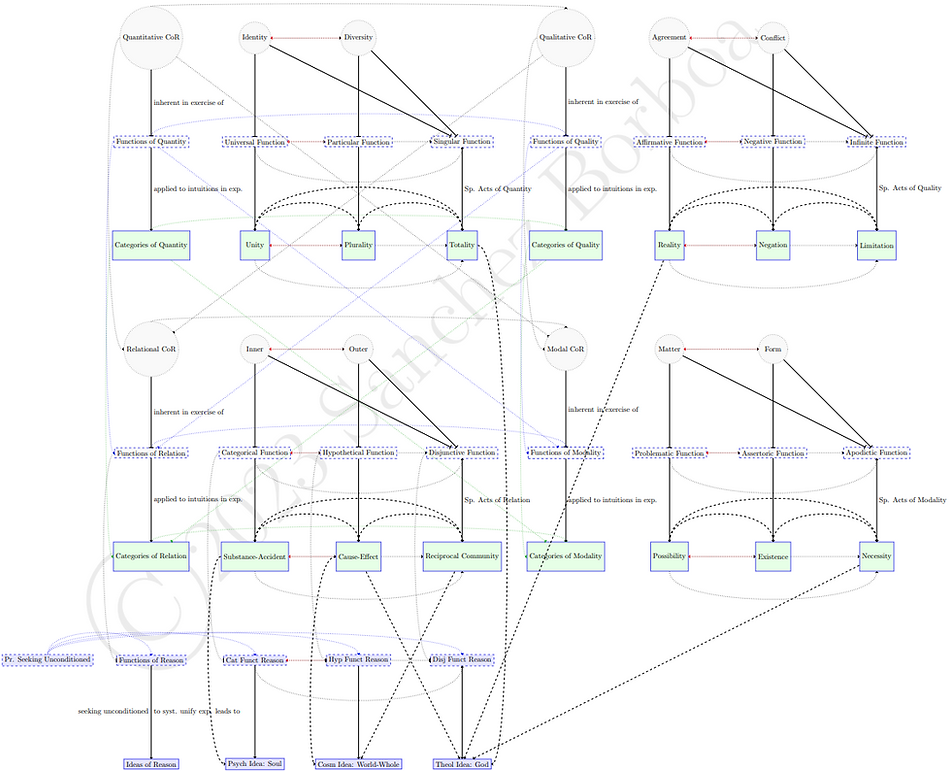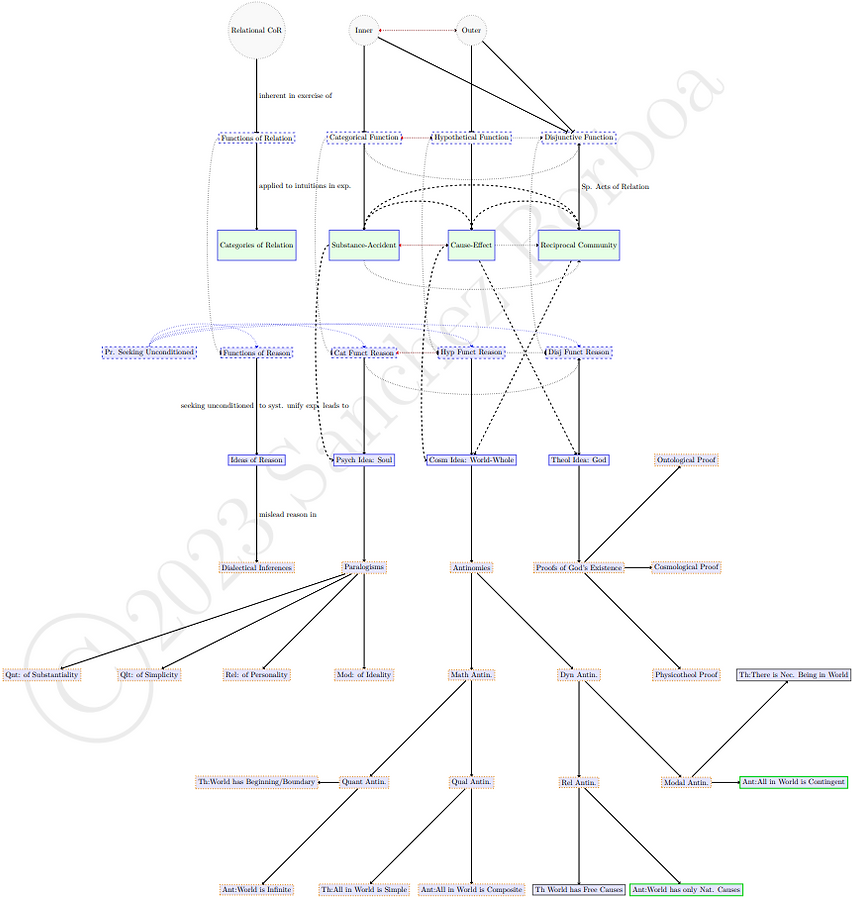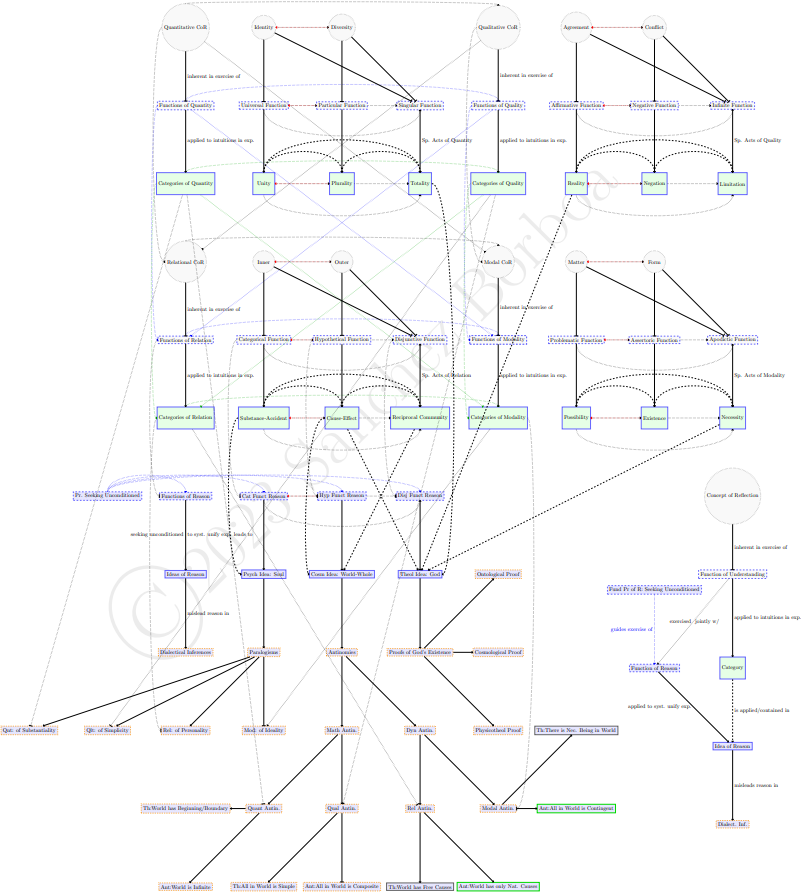Visualizing Kant's Critique of Pure Reason
General Structure
This page features diagrams of the structure of the "first" Critique of Pure Reason.
You can find diagrams corresponding to particular sections here:
The first diagram illustrates the main divisions of the work and some of the main concepts (represented in circles) and arguments (represented in dashed diamonds) treated within these sections. The fundamental principle reason (to seek the unconditioned for any given conditioned cognition, i.e., roughly to search for ultimate, unifying explanations for what we grasp) is featured in a dashed ellipse.

This second diagram illustrates the main sources of representations/cognition (Sensibility, Understanding, and Reason) with the main concepts flowing from these sources (in circles), and arguments (in dashed diamonds). These include:
For Sensibility, the
-
Metaphysical Exposition of Space
-
Transcendental Exposition of Space
-
Metaphysical Exposition of Time
-
Transcendental Exposition of Space
For Understanding, the
-
Metaphysical Deduction of the Categories
-
Transcendental Deduction of the Categories
For Reason, the
-
Paralogisms of Pure Reason (concerning the idea of the Soul), which are shown to be fallacious
-
Antinomies of Pure Reason (concerning the idea of the World), which are shown to be fallacious or to concern either things in themselves or as they appear
-
Proofs of the Existence of God (concerning the idea of God), which are shown to be ultimately impossible
For more information on and visualizations of the relationships between these different capacities, you can go here.

Transcendental Aesthetic
The below diagrams feature the main architectonic connections articulated within the first main section of the first Critique, the Transcendental Aesthetic (dealing with the essential features of Sensibility), and how these make possible genuinely a priori pure mathematics in which we demonstrate how the conclusions of proofs/calculations necessarily (deductively) follow from premises.

Transcendental Analytic of Concepts
The next diagrams illustrate the main architectonic connections in the Transcendental Analytic of Concepts, this diagram illustrates the connections between the concepts of reflection, functions of the understanding, and the forms of judgment. For more information on and visualizations of these architectonic structures, you can go here. Some of them are quite large, so for ease of viewing, you can find all the diagrams corresponding to the Transcendental Analytic and Aesthetic here.

This next diagram adds color-coded dotted connections indicating a progression between the headings.

This next diagram illustrates connections between the concepts of reflection, functions, and categories.

The next diagram once again adds color-coded dotted connections indicating a progression between the headings.

Transcendental Analytic of Principles
The next diagram turns to the architectonic connections in the Transcendental Analytic of Principles. It articulates connections between (a) the basic spontaneous cognitive resources of the Analytic of Concepts, (b) the transcendental schemata (of the power of judgment), and (c) the form of sensibility to which these schemata apply as "transcendental time determinations" that allow sensible intuitions given in sensibility to be subsumed under pure concepts of the understanding. You can learn more about these intriguing mediating transcendental structures here.

The next diagram once again adds to the previous one color-coded dotted connections indicating progressions between the headings.

The next diagram connects the resources of the Transcendental Analytic of Concepts to the Principles of Pure Understanding, indicating that these justify the application of the categories to intuitions, grounding our experience of objects through intuitions.

The next diagram once again adds to the previous ones color-coded dotted connections indicating a progression between the headings.


This last diagram in this section represents all the architectonic connections of the Transcendental Analytic (together with the Transcendental Aesthetic).

Transcendental Dialectic
The next diagrams turn to the architectonic connections between the Transcendental Analytic (dealing with the essence of the Understanding in the narrow sense, as the capacity for concepts/rules) and the Transcendental Dialectic (dealing with the essence of Reason, as the capacity for inferences/principles). Once again, some of these diagrams are quite large, so for ease of viewing, you can find them here.
This first diagram in this section connects the resources of the understanding with the functions and syllogisms/inferences of reason. The functions of reason are certain applications of the functions of relation of the understanding (categorical, hypothetical, and disjunctive) but insofar as they are directed by reason to seek unifying explanations in inferences/syllogistic explanations according to reason's fundamental principle of seeking the unconditioned (roughly seeking ultimate explanations). For more information on (and visualizations of) the relation between reason, understanding, and other cognitive capacities, you can go here.

The next diagram adds the usual connections indicating a progression between the headings of tables in the Analytic of Concepts in dotted lines as well as a supplementary explanatory diagram of the general pattern playing out across different elements.

The next diagram omits the logical inferences of reason and instead connects the transcendental ideas of reason with the fundamental resources of the understanding leading to the categories (treated in the Transcendental Analytic of Concepts). When the functions of reason are exercised (according to reason's fundamental principles) to seek the unconditioned in order to systematically unify experience, they generate the ideas of reason as applications of the categories beyond sensory experience. The dashed arrows indicate that the ideas of reason contain certain categories as components.

The next diagram omits all headings of the tables of functions/categories except relation and adds connections to the fallacious dialectical inferences that reason is naturally and essentially misled into when trying to reason using the ideas of the soul, the world, and God that stem from reason's very nature. The paralogisms of the soul and proofs of the existence of God, and the "mathematical" antinomies (of quantity and quality) are all fallacious according to Kant (as indicated by dotted yellow outlines). However, the dynamical antinomies (of relation and modality) each have a thesis that correctly applies to things in themselves (indicated by a black outline) and antithesis that correctly applies to things as they appear (indicated by a green outline).

The next diagram adds all the rest of the headings for functions and categories, showing connections between all of these elements, including dotted lines for when categories are used in dialectical inferences. It also includes a supplementary explanatory diagram detailing the general pattern that plays out across headings. This last diagram thus represents many of the main connections between the architectonic structures in the Transcendental Analytic and Dialectic and so between Understanding and Reason.
